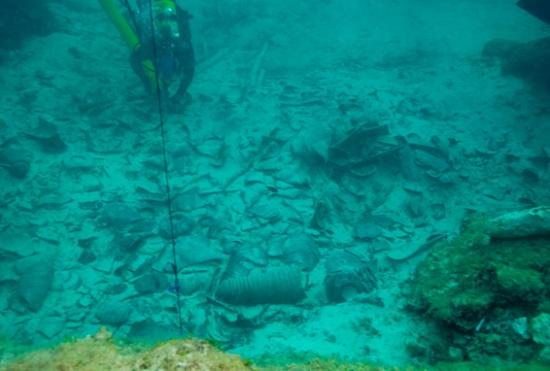Source - http://popular-archaeology.com/issue/03012014/article/archaeologists-uncover-ancient-punic-vessels-in-balearic-islands
The discovery was first made by students in 2013 while investigating underwater shipwreck remains near the ancient port of Sanitja on the island of Menorca, one of a number of picturesque islands that make up an archipelago of Spain in the western Mediterranean Sea.
They were ancient Punic amphorae, more than 150 of them, lying in situ, still at rest where a seagoing vessel identified with the site known as the Binisafuller wreck gave up its cargo more than 2,000 years ago. Archaeologists date the amphorae to between 325-275 BC. It makes the shipwreck the oldest documented one in Menorca.

A view of the Punic shipwreck cargo remains at the Binisafuller shipwreck site. Courtesy Ecomuseum de Cavalleria, Sanisera Field School
It is a significant discovery because the remains of the port of Sanitja have been most often associated with the adjacent Roman period city of Sanisera. In recent decades, surveys and excavations revealed structures and artifacts at the Sanisera location that revealed a long occupation of the city from the Roman Late Republican period until Late Antiquity. Surveys and excavations have been conducted at the site annually through an extensive field school under the auspices of the Ecomuseum de Cavalleria school. Although much of the work is conducted on land, a substantial aspect of the efforts involves underwater archaeology, where professional archaeologists and students will don scuba equipment and explore the depths to identify, record, and recover artifacts and structural remains of the port that served the city. Thus far, archaeologists have uncovered evidence such as structural timber remains from shipwrecks, numerous Roman amphorae, anchors, lead stocks and weights, and other cargo features and finds.
"Even though the northern coastline [of Menorca] is bare, uneven and rugged," wrote excavations director Fernando Contreras in a recent report, "the Port of Sanitja has always offered shelter to sailors and their boats. Even when the Tramontane blows strongly, the waters remain calm because of a submerged natural dike located at its entrance. For this reason, despite its compact dimensions, the port presents excellent conditions for the entrance and anchorage of vessels, and thus different cultures have continued to establish settlements here or use this enclave for a variety of purposes, such as the Arabs in Medieval times and the English in the Modern Period."*
Clearly this was the case for the Romans, as well --- and now, for an even earlier group of people, the Punics.
"This discovery increases the knowledge of navigation and the Punic trade in the Balearic Islands between the fourth and third centuries BC, something still quite unknown in our days," says Contreras.**
But, as Contreras emphasizes, Sanitja is about much more than Punic amphorae and shipwrecks.
"The existence of large amounts of artifacts from different periods speaks to the continuing activity that has taken place on the North coast of Menorca. The combination of land and underwater archaeological investigations in Sanitja are already providing excellent results which will be explored in depth during the next few years."*
More information about the Sanitja excavations and how one can participate can be found at the project website.